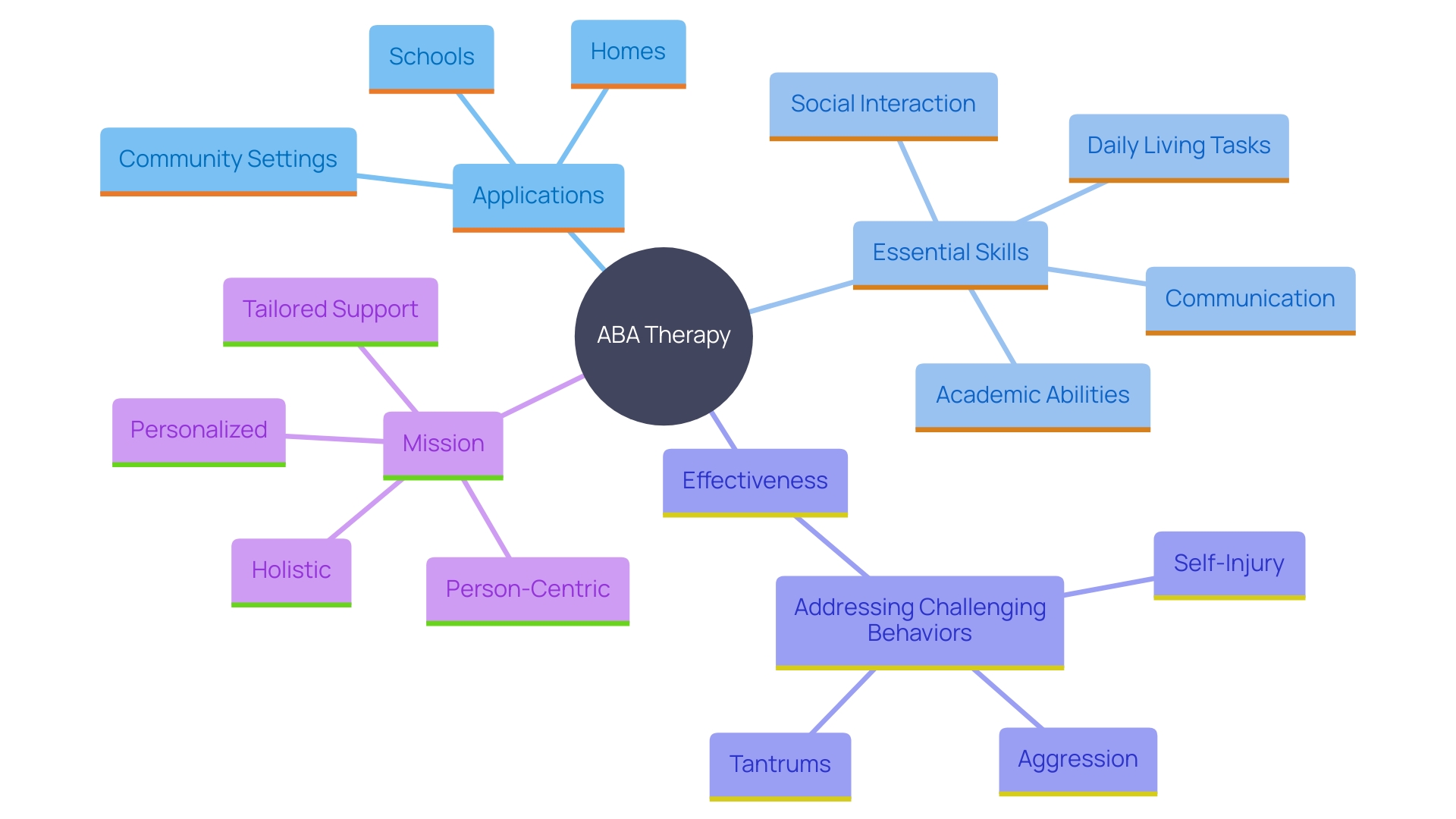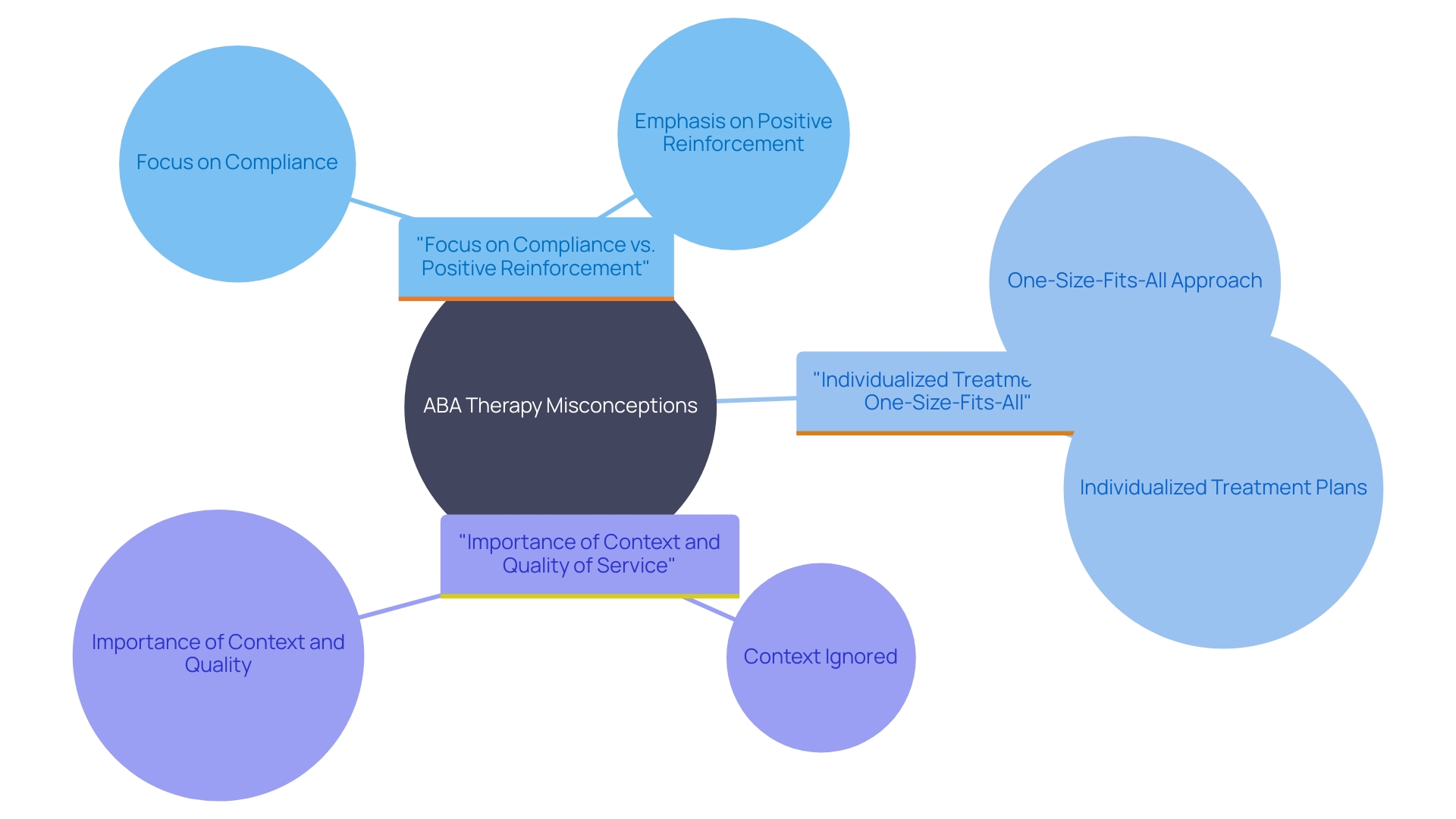Introduction
Navigating the complexities of raising a child with autism or other developmental disorders can be challenging for any parent. Applied Behavior Analysis (ABA) therapy emerges as a beacon of hope, offering a scientifically-backed method to understand and improve behavior. By focusing on real-world issues, ABA therapy aims to increase desirable behaviors and reduce challenging ones, making it a widely endorsed approach among researchers, practitioners, and many parents.
However, it is not without its critics, who argue that some aspects of the therapy may suppress behaviors that help autistic individuals manage anxiety. This article delves into the core principles, applications, and benefits of ABA therapy, while also addressing common misconceptions and the ongoing debates surrounding its use. Through a comprehensive exploration, the aim is to equip parents and advocates with the knowledge and resources necessary to make informed decisions, ensuring the well-being and development of their children in a supportive and empowering manner.
What Does ABA Therapy Stand For?
Applied Behavior Analysis (ABA) intervention is a scientific approach aimed at comprehending and enhancing actions. The term 'applied' signifies its focus on addressing real-world issues by increasing desirable behaviors and reducing challenging ones. ABA treatment is particularly effective for individuals with autism and other developmental disorders. It often involves children spending up to 40 hours a week with an ABA-certified therapist, who guides them through basic activities like using the bathroom, getting dressed, or writing their name. As children develop these skills, the intensity of therapy decreases, but many continue to receive support at home, in clinics, or at school.
While ABA is widely supported by researchers, practitioners, and parents, it faces criticism from some autism advocates. They argue that ABA can punish autistic children for actions that aren't harmful, such as 'stimming' activities like hand-flapping or finger-flicking, which help manage anxiety. Advocates believe society should accommodate these actions rather than try to eliminate them. Despite these debates, many families and professionals find ABA beneficial in promoting long-term gains in functioning.
A successful ABA program is built on several foundational pillars: individual assessment by a Board Certified Behavior Analyst (BCBA), specific and measurable goal setting, and consistent monitoring to adjust strategies as needed. Flexibility is crucial to accommodate the unique needs and schedules of families, ensuring effective support for both the child and their family members. Present evidence suggests that early and intensive behavioral interventions can significantly enhance social communication and adaptive skills, although more thorough studies are required to verify these findings and address potential negative effects.
Understanding the Basics of ABA Therapy
'ABA intervention, at its core, explores the complex connection between actions and the surroundings, utilizing the strength of reinforcement and consequence techniques to influence conduct.'. Grounded in the fundamental contributions of Skinner and Goldiamond, ABA therapy advocates for the application of positive reinforcement and highlights the importance of enhancing a client's strengths instead of merely concentrating on removing unwanted actions. This approach not only aligns with the moral imperative of fostering environments that support individuals in their pursuits but also prioritizes interventions that enhance the quality of life and promote skill acquisition.
The practice of ABA has evolved to incorporate a comprehensive understanding of the social significance of change targets, as outlined in the seminal ABA textbook by Cooper et al. This framework encourages analysts to consider a wide array of contextual factors, such as the potential for physical harm and the practical benefits of newly learned actions in real-life contexts. Despite some controversy surrounding ABA, particularly concerns about its impact on autistic traits, the latest guidelines by the Council of Autism Service Providers emphasize shared decision-making and collaboration with caregivers and clients, aiming to address these criticisms and enhance the therapeutic process.
By observing how actions are influenced by various environmental factors, ABA therapists can craft personalized interventions that not only foster skill development but also improve overall functioning in daily life. This personalized approach, rooted in empirical evidence and ethical considerations, aims to empower people with autism and related developmental disorders, ensuring that their unique needs and strengths are at the forefront of the therapeutic journey.
Key Principles of ABA Therapy
The key principles of ABA therapy—reinforcement, prompting, fading, and generalization—are fundamental to its practice. Reinforcement involves rewarding desirable behaviors to increase their occurrence, a method shown to significantly improve social engagements and reduce challenging behaviors among autistic children. Prompting offers cues to assist people in starting or finishing tasks, which has been effective in improving functional skills and communication. Fading gradually removes assistance to promote independence, allowing people to perform tasks without support eventually. Generalization is the ability to apply learned skills in various environments and circumstances, ensuring that progress is maintained beyond treatment sessions. This principle is essential for real-world application, helping individuals use their acquired skills across various environments and contexts. While ABA treatment has its controversies, with some self-advocates raising concerns about its impact on autistic traits, proponents emphasize its potential to enhance quality of life when implemented correctly. The latest ABA Practice Guidelines emphasize the significance of shared decision-making and teamwork with caregivers to ensure the effectiveness of the treatment.
Applications of ABA Therapy
ABA therapy is highly adaptable and can be implemented in various environments such as homes, schools, and community settings. It is extensively used to teach essential skills including communication, social interaction, daily living tasks, and academic abilities. Beyond skill development, ABA effectively addresses challenging behaviors like aggression, self-injury, and tantrums by providing strategies that assist people in managing and adapting to these behaviors. This approach aligns with the goal of creating a supportive and inclusive environment where people can thrive. As stated by Don Trainor, Care Transformation Senior Manager at Avesis, "Our mission is person-centric; we guide people, organizations, and communities to wellness by providing innovative, multidimensional, tailored offerings with a personal touch." This emphasizes the holistic and personalized nature of ABA support, ensuring that each person's unique needs are met with dignity and respect.

Benefits of ABA Therapy
ABA treatment provides a multitude of benefits that extend beyond the individual to the entire family unit. It fosters meaningful skill development by focusing on personalized goals set through thorough assessments, ensuring each child's unique needs are met. This targeted approach enhances communication and social interactions, crucial for children with autism who often face challenges in these areas. Research has shown that naturalistic developmental behavioral interventions significantly improve social communication, with measures indicating a notable positive impact on adaptive behavior, language, and play.
Moreover, ABA support promotes independence by teaching essential life skills. Children spend substantial time with ABA-certified therapists, learning basic activities like using the bathroom, getting dressed, or writing their name. As they master these skills, the intensity of treatment can be adjusted, allowing for continued support at home, in clinics, or schools. This structured, consistent approach not only builds a positive behavior framework but also encourages engagement in more adaptive behaviors.
Families, too, gain considerable advantages from ABA treatment. They are provided with tools and strategies that empower them to support their children's growth in everyday life. This empowerment is echoed in the anticipation that practitioners will find their roles feasible and effective, ultimately giving toddlers with early signs of autism access to early, developmentally appropriate interventions. These interventions are specifically tailored to address core social difficulties, making them more effective than other approaches for very young children with social communication challenges.
In essence, ABA support equips families with the knowledge and resources needed to foster their children's development, creating a supportive and enriching environment for growth.
Common Misconceptions About ABA Therapy
Despite its proven effectiveness, there remain several misconceptions surrounding ABA therapy. Some people perceive it as merely about compliance or control, but this understanding misses the mark. Instead, ABA concentrates on instructing and strengthening affirmative actions, a principle deeply embedded in Skinner’s work on positive reinforcement, which highlights assisting people in what they value. Additionally, Goldiamond's approach to ABA highlights beginning with a client’s strengths and building upon them, rather than just eliminating challenging behaviors.
Another common myth is that ABA is a one-size-fits-all solution. On the contrary, ABA is highly individualized, carefully tailored to each person’s unique needs and circumstances. The guidelines set by the Council of Autism Service Providers stress the importance of high-quality implementation adapted to each individual to maximize effectiveness.
Understanding these misconceptions is crucial for parents and advocates. Real-world examples, such as the efforts by Indiana parents to maintain ABA funding and the personal stories shared by families, underscore the positive impact of the treatment. For instance, the narrative of an autistic child in Virginia who, thanks to ABA, advanced from being non-verbal to leading the Pledge of Allegiance in public, illustrates the transformative potential of this approach.
Moreover, addressing the diversity in experiences and the importance of context, Autism Speaks’s chief science officer, Andy Shih, notes that the quality of service and the setting significantly influence outcomes. Recognizing these nuances helps parents and advocates make informed decisions and ensures that ABA therapy is used to its fullest potential to support children's development and well-being.

Conclusion
Navigating the complexities of raising a child with autism or other developmental disorders can feel overwhelming, but understanding the principles and benefits of Applied Behavior Analysis (ABA) therapy can provide clarity and hope. Central to ABA is its focus on real-world applications, promoting desirable behaviors while addressing challenges through individualized assessment and evidence-based strategies. This approach not only enhances skill acquisition but also fosters independence, creating a supportive environment for children to thrive.
Despite the ongoing debates surrounding ABA therapy, it is essential to recognize its adaptability across various settings, including homes and schools. The therapy's emphasis on collaboration with families ensures that interventions are tailored to meet the unique needs of each child, maximizing their potential for success. With a strong foundation in positive reinforcement and ethical considerations, ABA therapy empowers individuals to develop essential life skills, improving their overall quality of life.
Addressing common misconceptions about ABA therapy is crucial for parents and advocates. Understanding that ABA is not merely about compliance but rather about fostering positive behaviors can reshape perceptions and support informed decision-making. Real-life success stories highlight the transformative impact of ABA, reinforcing the importance of high-quality, individualized interventions.
By equipping families with the necessary tools and resources, ABA therapy stands as a vital ally in the journey toward nurturing the growth and well-being of children with autism and related developmental disorders.




